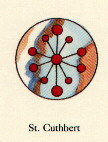St. Cuthbert
MYTHS & LEGENDS
The Saint Among Us. This is a story of Saint Cuthbert's origins as a mortal shepherd who long ago lived a simple, blameless, charitable life. He was rewarded by the gods by being brought to Primea where he walked the world as a holy man teaching evil the error of its ways. Eventually he became a god; the tale attempts to guide others by example.
Parables of the Wise Fool. The dogmatically correct stories that the Tales of the Vulgar Fool work of heresy is a parody of, these stories involve agriculture, animal husbandry, crafts, fending off beasts, fighting, and other common activities. The protagonist, the Wise Fool, is normally portrayed much as St. Cuthbert is, as a young or middle-aged man with a crumpled hat, who shows up well-meaning but self-important antagonists with simple common sense. Many of the most common sayings used in the Cuthbertine faith are attributed to the Wise Fool. These books are often illustrated, and simple paintings of the Wise Fool are common on rural chapels and the like.
The Boy Who Cried Wolf. This story, possibly brought by Saint Cuthbert himself from another world, tells of a shepherd boy who tells lies about a wolf attack and is consequently not believed when a wolf actually attacks. A variation of this story is "The Boy Who Cried Orc."
Relationships
St. Cuthbert is a foe of many evil deities, including Iuz and Vecna . He also has an intense rivalry with Pholtus, a similarly intolerant though good-leaning god.
St. Cuthbert is strongly allied with Rao . He is an ally of Heironeous , and Pelor as well.
REALM
When they shed their mortal coils, those who worshiped the saint in life go to Saint Cuthbert's divine realm, called the Basilica of St. Cuthbert or the Bastion of Law. This realm is in Arcadia. Souls there act as silent observers while the saint gives out judgments from his Seat of Truth. St. Cuthbert seldom leaves his plane unless some great duty calls him forth.
SCRIPTURES
St. Cuthbert and Common Sense. This short book, normally no more than thirty pages long, uses simple language to explain the tenets of Saint Cuthbert's faith. Some personal interpretation is permitted, but the essentials (obey the law, be good, and use common sense) remain the same. Those who fail at living up to the Saint's virtues are advised to turn to their communities for advice and support, and to pray to St. Cuthbert to clear up their confusion. Copies of Saint Cuthbert and Common Sense are normally written by hand in easy-to-read letters, sometimes with simple drawings. Gilded illuminations and elaborate calligraphy are not in harmony with the Cuthbertine aesthetic.
Tales of the Vulgar Fool. This book is considered foul heresy in the eyes of Cuthbertines, particularly the Order of the Stars, who try to suppress it whenever it is encountered. It takes the traditional Cuthbertine parables of the Wise Fool and twists them so that instead of overcoming his problems with common sense, he indulges in thievery and lechery. Non-Cuthbertines see these stories as humorous parodies of uptight Cuthbertine homilies, but the church does not approve. A small minority of the faithful take the Tales of the Vulgar Fool to heart and incorporate their "advice" into their lives, and this is the sort of thing the Order of the Stars tries to stamp out.
ARTIFACTS & RELICS
Saint Cuthbert wields a powerful artifact called the Mace of Cuthbert. Other magic items associated with Saint Cuthbert include the cudgel that never forgets and the tabard of the great crusade.
CLERICS
Saint Cuthbert's priesthood is divided into three major orders.
The Chapeaux, whose symbol is a crumpled hat, seek to convert people into their faith. They are equally divided between lawful good and lawful neutral characters. Paladins of Saint Cuthbert, known as Votaries or Communicants, have an honorary position in the Order of the Chapeaux. Their role is not just to convert others, but to actually fight enemies of the faith.
The Stars, whose symbol is a starburst, seek to enforce doctrinal purity among those already dedicated to the saint. Most are lawful neutral, and they do not shy from using mind-reading magic in order to ensure that even the private thoughts of their flock are pure.
The Billets are the most numerous of Saint Cuthbert's clergy. Most are lawful good, and they seek to minister to and protect the faithful. These are well-beloved by the common folk. Their symbol is a wooden club. The Chapeaux often come into conflict with the Billets, because the former order wants to seek new converts while the latter wants to care for the worshipers they already have.
MINOR ORDERS
There are a few lesser-known orders of St. Cuthbert.
L'Ordre de la Croix-Rose Veritas, or the Order of the Rosy Cross of Truth. It was founded by Ormus, a former priest of Rao only just converted to St. Cuthbert's faith himself. When Ormus discovered an evil warlord had been corrupted by a devil in disguise, he founded the new order in order to track down other devils living among mortals in disguise. The order has three branches: La Croix-Vert, La Croix-Blanc, and La Croix-Bleu.
The Society of the Sanctified Mind focuses on ridding the world of evil psionicists. It was founded by a cleric of St. Cuthbert named Sir Jeremy Costineux, after his home village was enslaved by illithids. This society is a knightly order rather than a strictly religious one, and people of a wide variety of character classes belong to it.
TEMPLES
St. Cuthbert's churches can be large cathedrals, but most commonly are wayside shrines and small, crude chapels.



Comments